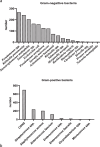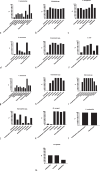Bacterial etiology and antimicrobial resistance pattern of pediatric bloodstream infections: a 5-year experience in an Iranian referral hospital
- PMID: 38565980
- PMCID: PMC10988941
- DOI: 10.1186/s12879-024-09260-w
Bacterial etiology and antimicrobial resistance pattern of pediatric bloodstream infections: a 5-year experience in an Iranian referral hospital
Abstract
Background: Bloodstream infections (BSI) are the major cause of morbidity and mortality in children in developing countries. The purpose of the current study was to establish the antimicrobial susceptibility pattern of bacterial isolates from bloodstream infections at Children's Medical Center Hospital (CMC), Tehran, Iran.
Methods: We retrospectively recorded all positive blood cultures and antimicrobial susceptibility of all bloodstream isolates among children admitted to CMC, during 5 years. Specimen culture, bacterial identification, and antimicrobial susceptibility testing were performed according to standard laboratory methods.
Results: From 3,179 pathogens isolated from the blood cultures 2,824 bacteria were cultured, with 1,312 cases being identified as Gram-positive bacteria (46%) and 1,512 cases as Gram-negative bacteria (54%). The most common Gram-negative bacteria isolated were as follows: Pseudomonas spp. (n = 266, 17.6%), Klebsiella pneumoniae (n = 242, 16%), Stenotrophomonas maltophilia (n = 204, 13.5%), Enterobacter spp. (n = 164, 10.8%), Escherichia coli (n = 159, 10.5%), Pseudomonas aeruginosa (n = 126, 8.3%), Serratia marcescens (n = 121, 8%), and Acinetobacter baumannii (n = 73, 4.8%). The most common Gram-positive bacteria isolated were coagulase-negative staphylococci (CONS) (n = 697, 53%), Streptococcus spp. (n = 237, 18%), Staphylococcus aureus (n = 202, 15%) and Enterococcus spp. (n = 167, 12.7%). 34% of bacterial strains were isolated from ICUs. The rates of methicillin resistance in S. aureus and CONS were 34% and 91%, respectively. E. coli isolates showed high resistance to cefotaxime (84%). All isolates of K. pneumoniae were susceptible to colistin and 56% were susceptible to imipenem. P. aeruginosa isolates showed high susceptibility to all antibiotics.
Conclusions: Our findings emphasize the need of clinicians having access to up-to-date bacterial susceptibility data for routinely prescribed drugs. Continuous monitoring of changes in bacterial resistance will aid in the establishment of national priorities for local intervention initiatives in Iran. The increased risk of BSI caused by antibiotic-resistant organisms, emphasizes the significance of implementing appropriate antibiotic prescribing regulations and developing innovative vaccination techniques in Iran.
Keywords: Antimicrobial susceptibility; Bacteria; Bloodstream infection.
© 2024. The Author(s).
Conflict of interest statement
The authors declare no competing interests.
Figures



References
-
- Thaulow CM, Lindemann PC, Klingenberg C, Berild D, Salvesen Blix H, Myklebust TÅ, et al. Epidemiology and Antimicrobial susceptibility of invasive bacterial infections in children—a population-based study from Norway. Pediatr Infect Dis J. 2021;40:403–410. doi: 10.1097/INF.0000000000003013. - DOI - PubMed
-
- Mamishi S, Mohammadian M, Pourakbari B, Hosseinpour Sadeghi R, Haghi Ashtiani MT, Abdosalehi MR, et al. Antibiotic resistance and genotyping of gram-positive bacteria causing hospital-acquired infection in patients referring to children’s medical center. Infect Drug Resistance. 2019;12:3719–26. doi: 10.2147/IDR.S220522. - DOI - PMC - PubMed
MeSH terms
Substances
LinkOut - more resources
Full Text Sources
Medical
Miscellaneous

